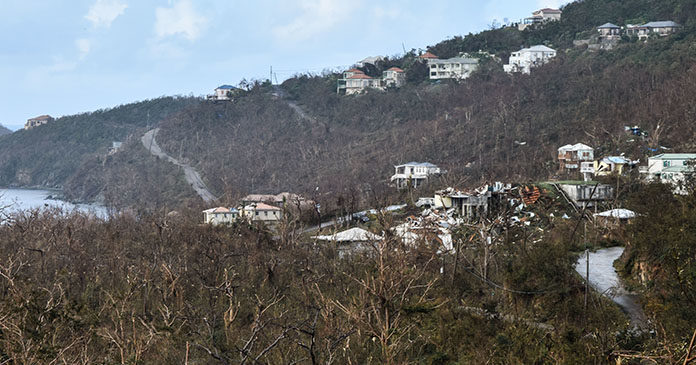U.S. Department of Housing and Urban Development (HUD) Deputy Secretary Pamela Hughes Patenaude and the U.S. Virgin Island’s Governor Kenneth Mapp today announced the formal execution of a $243 million grant agreement to help citizens in the U.S. Virgin Islands to recover from Hurricanes Irma and Maria. The signing of this grant agreement now paves the way to speed recovery dollars needed to restore damaged and destroyed homes, businesses and infrastructure.
The U.S. Virgin Islands’ long-term recovery is supported through HUD’s Community Development Block Grant-Disaster Recovery (CDBG-DR) Program, which requires grantees to develop thoughtful recovery plans informed by local residents. Learn more about CDBG-DR and the State’s role in long-term disaster recovery.
“Today, we take another important step in the process of rebuilding damaged homes, restoring shuttered businesses and repairing critical infrastructure,” said Deputy Secretary Patenaude. “With the formal execution of this grant agreement, the real brick-and-mortar recovery work can begin.”
“On behalf of the people of the Virgin Islands, I thank Secretary Carson, Deputy Secretary Patenaude and all the HUD staff for working so closely with us to finalize this grant,” Governor Kenneth Mapp said. “We look forward to being able to speed up assistance to homeowners and to construct new housing for seniors and others in need. We now have the opportunity to make permanent repairs to public housing and provide assistance to private landlords as we work to rebuild our housing stock. HUD is also helping us ensure that more Virgin Islanders have the opportunity to be a part of the rebuilding process through funding training for work in the construction trades.”
To address unmet needs, the U.S. Virgin Islands identified several housing, infrastructure and economic development recovery needs arising from Hurricanes Irma and Maria. The U.S. Virgin Islands disaster recovery action plan includes the following activities:
Homeowner Rehabilitation and Reconstruction Program ($10 million) – This program is available to eligible homeowners for properties that were damaged by Hurricanes Irma or Maria.
New Construction for Homeownership Opportunity and First Time Homebuyer Assistance ($10 million) – This program is designed to address post-disaster housing affordability challenges and enable renters to become homeowners.
Rental Rehabilitation and Reconstruction ($5 million) – This program provides funds for the repair or replacement of damage to rental housing owned by the Virgin Islands Housing Authority, Virgin Islands Housing Finance Agency, and private landlords.
Public & Affordable Housing Development ($32 million) – These funds are targeted for the redevelopment and creation of new affordable housing, including subsidized and mixed-income rental units.
Supportive Housing & Sheltering Programs ($15 million) – The U.S. Virgin Islands recovery plan includes an effort for the rehabilitation, reconstruction, and development of housing for vulnerable populations, particularly among low-income seniors and those persons and families experiencing homelessness. This program also includes the development of emergency shelters for individuals and families who cannot shelter in place during disasters. The emergency shelter housing would also serve persons who require short-term housing because they are temporarily displaced.
Infrastructure ($125,549,800) – These funds are targeted for three infrastructure activities: 1) Local Match for Federal Disaster Relief Programs ($50,549,800) to help finance educational facilities, energy, hospitals, telecommunications, transportation, waste management, and water/wastewater management; 2) Infrastructure Repair and Resilience ($30,000,000) and 3) Electrical Power Systems Enhancement and Improvement ($45,000,000).
Economic Revitalization ($33 million) – Through this program, the U.S. Virgin Islands seeks to revitalize the post-disaster economy, including ($23 million) for Ports and Airports Enhancements, including harbor dredging to allow for larger cruise ships; 2) a Workforce Development Program to train low- and moderate-income residents to fill the construction and other jobs coming from recovery investments ($5,000,000); and 3) the Tourism Industry Support Program ($5,000,000), which will require a waiver by HUD, for marketing to communicate that the USVI is open for business.
Background
On September 8, 2017, President Trump signed the Additional Supplemental Appropriations for Disaster Relief Requirements Act, 2017. The Act appropriated $7.4 billion in CDBG-DR funding for major disasters declared in 2017. To distribute these funds, the Act requires HUD to direct the funds to the areas most impacted by last year’s major disasters. On February 2, 2018, HUD allocated $243 million of that appropriation to the U.S. Virgin Islands to address the serious unmet needs on the islands. The action plan approved today will put these funds to work.
On April 10, 2018, HUD allocated another $1.6 billion to further support recovery in the U.S. Virgin Islands and to rebuild communities impacted by Hurricanes Maria and Irma and to protect them from major disasters in the future. HUD will shortly publish program rules to guide the U.S. Virgin Islands and others on the use of those funds.
CDBG-DR grants support a variety of disaster recovery activities including housing redevelopment and rebuilding, business assistance, economic revitalization, and infrastructure repair. Grantees are required to spend the majority of these recovery funds in “most impacted” areas as identified by HUD. HUD will issue administrative guidelines shortly for use of the funds to address grantees’ long-term recovery needs, particularly in the area of housing recovery.













